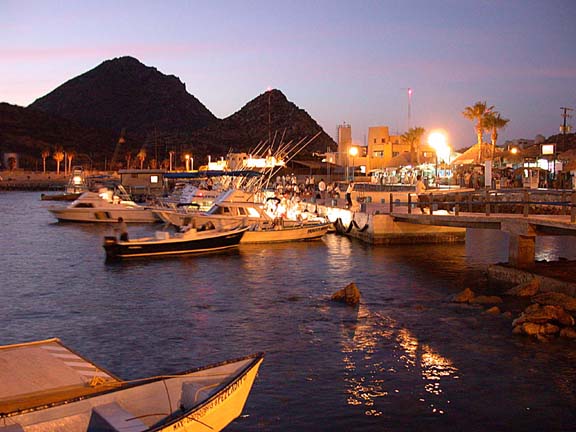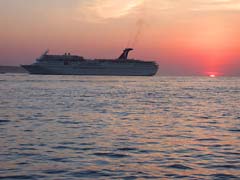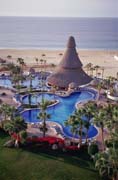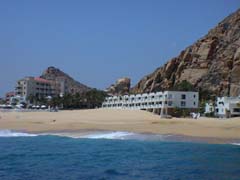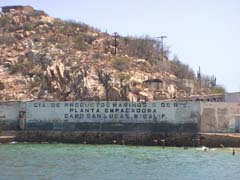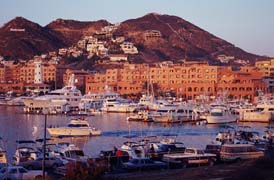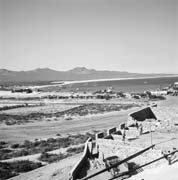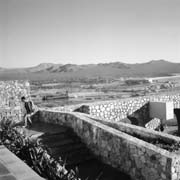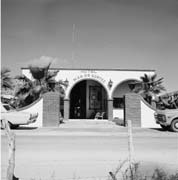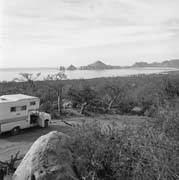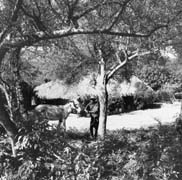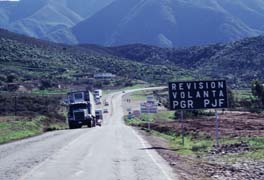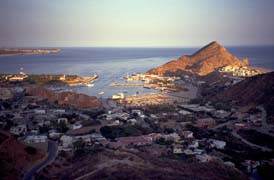
History of Cabo San Lucas, Mexico
![]()
|
The modern, world famous resort of Cabo San Lucas, B.C.S., Mexico. Fleet charter cruisers crowding in at the downtown harbor marina to pick up their sportfishing clients at first light. |
CABO SAN LUCAS: SPORTFISHING MECCA OF BAJA CALIFORNIA SUR, MEXICO
It's 5:30 a.m. in the quiet marina harbor of Cabo San Lucas, and the circle is about to become a dot.
Every thirty seconds or so, another diesel engine rattles to life in the humid darkness here at the very tip of Baja California, and the air moves slightly as another boat flicks on its lights and its crew wordlessly begins preparations for another day.
Faster and faster, the diesels growl--more than a hundred boats will fish this morning--and the lights begin to move across the water toward the busy pier below the rocky promontory of million dollar homes known as the Pedregal.
|
|
The pier is already crowded with anglers, who stand milling about in the harsh lamp light with their rods and tackle boxes. The tropic air is very warm, and they have already begun to glisten with perspiration and suntan lotion. It will be hot today.
At exactly 5:54, the first cruiser backs up to the dock and takes on its load of clients. With alphabetical propriety, the first boat this morning is named Aby, but it is soon followed out of the harbor by a fleet of other names that have become local legends: Gaviota, Solmar, Minerva, Pisces, Juanita, Mucho Loco, and many more.
This is Cabo San Lucas, the world capital of sport fishing, and this afternoon, those boats will return with their flags flying. Enormous fish will be hung for photographs, and the filleting tables will be busy with tuna and dorado, wahoo, and those billfish that could not be successfully released.
As the tired and sunburned tourists return to their hotels, few will remember their boats passing by a very small wooden dock near the harbor entrance, a dock so old and rickety that it threatens to collapse under the weight of the half-dozen young boys that always seem to be fishing there.
The dock projects out over the water from the faded remains of an old concrete building and on its side one can barely read the inscription: "Cia. de Productos Marinos, S. de R.L., Planta Empacadora, Cabo San Lucas, B. Calif."
It seems to be just an anonymous old building, lost amid the glitter and drama of a thriving, modern tourist destination, but what very few visitors today realize is that as recently as 1962, this building and a few shacks scattered around it constituted the entire settlement of Cabo San Lucas, which at that time had a total population of only about 300 cannery workers and their families.
The cannery had been established in 1927, and at its peak was the largest in Latin America, producing about 75% of Mexico's output of canned seafood products. It was preceded in Cabo San Lucas by a tall, four-masted sailing cannery ship anchored near the arches--where the cruise ships anchor today. That ship was kept supplied with tuna by a fleet of rowed skiffs and small jig boats.
|
Today, cruise ships anchor in the outer harbor of Cabo San Lucas, very near where Thomas Cavendish sacked and burned the Spanish Manilla Galleon, Santa Ana, in 1587. In 1972, the deluxe Hotel Finisterra, center, was built atop Baja's final promontory dividing the Pacific Ocean from the Sea of Cortez. One year later, the 1,000-mile Transpeninsuar Highway was completed, connecting Cabo San Lucas with the U.S. Border at Tijuana. Luis Coppola Bonillas, c. 1944, in the cockpit of his B-17 bomber in England, right. During World War II, Coppola flew 35 missions over Europe as a pilot for the U.S. Eighth Air Force. With his wife, Evangelina Joffroy, he established the Hotel Los Arcos in La Paz and the Hotel Finisterra in Cabo San Lucas. (Reprinted with permission from The Unforgettable Sea of Cortez.) |
But the real story of this cannery lies not in the harbor, but behind the high ridge of rocks that forms its picturesque setting. That ridge leads out to the stark pinnacles and famous arch at land's end, and on its western side, facing the open Pacific Ocean, is the magnificent Solmar Suites resort hotel, which opened in 1974.
The builder of that hotel was Luis Bulnes Molleda, who had originally come to Cabo San Lucas in 1955 to be the manager not of a luxury resort, but of the very tuna cannery that sits crumbling today only a few hundred yards away from the Solmar, and that story of Don Luis' metamorphosis from commercial fishing manager to hotelier is in many ways symbolic and representative of the story of modern Cabo San Lucas.
The European discovery of southern Baja California dates from the great Spanish explorations of the Sixteenth Century, and includes landings by such soldier-navigators as Hernán Cortes, Francisco de Ulloa, and Juan Rodriguez Cabrillo. In 1542, Cabrillo landed and took on fresh water at the estuary of San Jose del Cabo, and within a few decades, the treasure-laden Manila Galleons had established their clockwise route around the Pacific Ocean between the Philippine Islands and the Mexican coast at Acapulco. Cabo San Lucas became an ideal ambush point for English pirates such as Francis Drake and Thomas Cavendish, who would lie in wait in the lee of the arch at land's end, and venture out to sack the heavily laden Spanish ships. One of the most successful of these attacks came in 1587, when Cavendish successfully captured the 700-ton Santa Ana and set her aflame in the outer harbor of Cabo San Lucas, just off the present-day beach of the Hotel Hacienda.
It was not until the establishment of the Jesuit mission of San Jose del Cabo in 1730 that European presence in the Los Cabos area became more or less permanent, but this development was offset by a precipitous decline in the indigenous population due to the introduction of diseases, leading eventually to the de facto abandonment of the mission system in southern Baja by about 1800.
|
The Solmar Suites resort hotel faces the open Pacific at the extreme tip of Baja California. In the building at its far right, the Ray Cannon Suite, Baja's most southerly lodging accommodations. Pioneering hotelier, Luis Bulnes Molleda, center, owner of the Solmar Suites resort hotel, at the entrance to the hotel's Ray Cannon Suite, the most southerly lodging accommodations in Baja California. The abandonded shell of the historic Cabo San Lucas tuna cannery, right, built in 1927 and kept in operation until 1980. (Reprinted with permission from The Unforgettable Sea of Cortez.) |
For the next one-hundred years, such historic watershed events as independence from Spain, incursions from various foreign adventurers, the Mexican-American war, the Mexican Revolution, and the innovations of the Industrial Revolution touched daily life at the tip of Baja California to a remarkably small degree. By the early years of the Twentieth Century, Cabo San Lucas and San Jose del Cabo were sleepy outposts of "Californio" cattle ranchos and small farms, rarely visited by outsiders.
Regular contact with the modern world came suddenly with the exploitation of immense schools of tuna within sight of the harbor, and the arrival of the first cannery ships in the early 1920s. The building of the historic cannery at Cabo San Lucas in 1927 initiated a period of intense commercial fishing. During this era, tall-masted sailing ships plied the Pacific Coast of Baja California, visiting not only the Cape area, but also entering Bahia Magdalena and netting enormous fish in the shallow water there. In Cabo San Lucas, a community of a few dozen extended families grew up around the cannery, and life settled into a routine that would persist relatively unchanged for more than a quarter-century.
In the late 1950s, a decision critical to the future of Baja California was made by the federal government in Mexico City: Cabo San Lucas would cease to be a cannery town, and would be developed instead as a major tourist destination based on sport fishing. There were protests and complaints from the local population, but nevertheless a new cannery was built at San Carlos at Bahia Magdalena, and the very first of Cabo's great resorts opened its doors in 1963: the original Hotel Hacienda built by Rod Rodriguez, son of former Mexican president Abelardo Rodriguez.
|
Cabo's marina was dredged out of a dry mudflat in 1974 and 1975. Until that time, a landing strip and the houses of cannery workers occupied the area shown here. Cabo San Lucas, c. 1970, right, from the construction site of the Hotel Finisterra. Note cannery still in operation, Hotel Hacienda on low sand dune at left, and landing strip where today's marina is now located. (Reprinted with permission from The Unforgettable Sea of Cortez.) |
Although the Hacienda was the first hotel in Cabo San Lucas itself, it had been preceded by other early fly-in resorts situated on the coast of the southern half of the Sea of Cortez. These included such legendary pioneering establishments as the Flying Sportsmen Lodge built by Ed Tabor in Loreto (1952), the Serenidad built by Don Johnson in Mulege (1961), the Hotel Los Arcos developed in La Paz by Luis Coppola Bonillas (1952), Rancho Buena Vista built by Herb Tansey at East Cape (1952), and the nearby Hotel Cabo San Lucas built by William Matt "Bud" Parr (1961).
Two other earlier resorts had also been built by Rod Rodriguez himself, the Palmilla at San Jose del Cabo (1956), and the very first of the first, Rancho las Cruces, Baja's original luxury fishing resort, built on the beach at the base of a remote arroyo near La Paz in 1950.
In Cabo San Lucas itself, the Hacienda was followed by the awe-inspiring Hotel Finisterra (1972) built by Luis Coppola Bonillas and Luis Bulnes Molleda high atop the final promontory of land separating the Pacific Ocean and the Sea of Cortez. Two years later, Bulnes opened Baja's "last resort," or as he prefers to say, its "first resort," on the final wide sandy beach that lead's out to the famous arch at land's end. Regardless of whether it is "first" or "last" the Solmar Suites does contain Baja California's southerly-most lodging accommodations, the super-deluxe "Ray Cannon Suite," which is named after the period's seminal Baja columnist for Western Outdoor News, and which is built directly into the living rock at the end of the 700-mile-long peninsula.
Although many of Baja's early resorts were humble projects, some opening with as few as four rooms, the hotels of the Los Cabos corridor were large and ambitious right off the drawing board; they were financed and built with a confidence that, somehow, the relatively enormous investment could be paid off in this very remote land that had not even a paved road to connect it to any major population center.
That confidence was justified not only because of the uniqueness of the natural beauty of Baja California Sur, but also because of its relative proximity by air to Southern California, and because of a number of decisions that were already being made in Mexico City concerning the development of infrastructure critical to the future of the region.
By 1958, references had already begun to appear about a project so outrageous that few thought it could ever be built: a paved highway more than 1,000 miles long that would connect the U.S. border with Cabo San Lucas. In fact, within a few years, segments of that future road were being graded, outwards from the territorial capital of La Paz, and southwards from Ensenada. Work proceeded in fits and starts, but almost two decades after it was first seriously proposed, the amazing Transpeninsular Highway was finally completed and dedicated at its midpoint at Guerrero Negro on December 1, 1973.
That very narrow two-lane road opened the remote deserts and beaches of Baja California not only to the wealthy, but to millions of middle class tourists, who drove down in such great numbers that they touched off a peninsula-wide building boom of roadside restaurants, motels, campgrounds, and RV parks that persists to the present day. Wherever it passed, along the entire length of Baja California, "Mex 1" brought prosperity to a whole generation of families.
Thus, Cabo San Lucas was connected to its market by land in the 1970s, but at the same time work had also already begun to provide access both by water and by air. The water connection is deserving of special mention, because its creation was the dominant factor in shaping the physical layout and appearance of the city today.
|
Dredging the inner harbor, c. 1974, from the completed Hotel Finisterra. Cabo San Lucas, c. 1975, center. In two years, the expanded international airport at San Jose del Cabo would open. The Puerto Vallarta Ferry, shown tied up at the new pier, was kept in operation until 1986. The original building of the Hotel Mar de Cortez, right, opened in downtown Cabo in 1972 by Simon Yee and Carlos Ungson. (Reprinted with permission from The Unforgettable Sea of Cortez.) |
|
Entering Cabo San Lucas, 1961. Just visible is the only major structure in town, the cannery located on the beach under the lowest point of the ridge. The Hotel Hacienda would not be built for another two years. San Jose del Cabo, c. 1957, right. Photo by Harry Merrick. (Reprinted with permission from The Unforgettable Sea of Cortez.) |
If one looks out over the present marina harbor of Cabo San Lucas, now surrounded by hotels and stores, and filled with boats of every description, it is more than a bit difficult to realize that when the Hotel Hacienda and the Hotel Finisterra were built, there was no harbor. These great resorts, so dependent upon sport fishing, were completed at a time when the entire marina area was nothing more than a dry mud flat with a landing strip running down its middle and the small houses of cannery workers scattered among the bushes here and there.
Today's Hotel Hacienda appears to be sitting on a sand dune that ends at the harbor entrance channel, but that was not always the case. When the Hacienda was built in 1963, that sand dune extended at nearly its full height all the way across the channel and ended near the rocks just north of the cannery. Only a small seasonal stream bed cut through the dune to let floodwaters out during storms. Amazingly, the original Hacienda survived for the next decade with no marina and no paved road. Customers arrived mainly in small planes that would come in low over the future site of the Hotel Finisterra and then dive for the runway on the mud flat.
Finally, almost simultaneously with the dedication of the Transpeninsular Highway in 1973, large dredging equipment was brought to Cabo San Lucas, and a year later the sand dune had been cut away and enough of a harbor had been created to allow the entrance of an oceanic ferryboat from Puerto Vallarta. Cabo San Lucas was now connected to the Mexican mainland by ferry and to the U.S. border by road. Further dredging created the rest of the marina as it is known today, and all around its edge, some of the most commercially valuable resort property in the world.
|
|
Although Cabo San Lucas' first connections to the outer world were by land and by sea, it was the connection by air that was most important in shaping the Los Cabos Corridor as we now know it. The first airline to service southern Baja California was Aeronaves de Mexico, which began flights between the mainland and La Paz in 1941. After World War II, Mayo Obregón, established Trans Mar de Cortes using war surplus DC-3s and hiring as his first pilot, none other than Luis Coppola Bonillas, who would later own the Hotel Los Arcos and build the Hotel Finisterra (it was a small world in those days). Other early airlines and air taxi services included independent bush pilots such as Francisco Munoz, and companies such as Servicios Aereos de La Paz (later Aerocalifornia) and Lineas Aereas del Pacifico.
But it was only after 1962 when Trans Mar de Cortes was taken over by Aeronaves de Mexico, that scheduled air traffic began to assume the important role that it plays today in bringing tourists to Baja California Sur. In that year, DC-6 propeller service was begun between Los Angeles and La Paz, followed by the first DC-8 jets in 1966.
Then, in 1977, Los Cabos International Airport at San Jose del Cabo underwent a major expansion and opened in its present form with a capacity of thousands of passengers per day, ushering in the modern age for the glittering 60-mile coastline from East Cape to Cabo San Lucas.
As the people of the Los Cabos corridor have transformed their once forgotten land into a major tourist destination and the crown jewel of the world of sport fishing, it has become difficult to discern the relics, the values, and the quiet, gracious lifestyle of a past that is still within the memories of many who live here. Much has been gained, but much that is beautiful and valuable has also been lost. In the coming decades, it will be critically important to heed the words of such farseeing pioneers as Luis Bulnes Molleda, a man of both the old tuna cannery and today's Solmar Suites resort hotel:
"When I first came here, you could leave your doors open, and all you would get in your house would be maybe a burro. Of course, we must pay a certain price for progress, but we must also be very careful. I believe in the future. I don't care who is in a position of leadership here, but whoever that is must look to the future, not just now, but at least 25 to 30 years from now."
|
Only one-thousand more miles to Cabo San Lucas. The Transpeninsular Highway, completed in December 1973, is shown at the first miliaary checkpoint, a few miles south of Ensenada. At right, modern Cabo San Lucas. In 1973, only two buildings visible in this photo, existed, the tuna cannery, located at the right edge of the harbor entrance, and hidden in the trees on the opposite side of the channel, the Hotel Hacienda built by Rod Rodriguez in 1963. The town landing strip was located where the marina is today. |
(Related Cabo San Lucas articles and reports may be found at Mexfish.com's main Cabo San Lucas information page. See weekly fishing news, photos, and reports from the major sportfishing vacation areas of Mexico including the Cabo San Lucas area in "Mexico Fishing News.")
MEXICO FISHING INFO CABO SAN LUCAS FISHING INFO "WEEKLY MEXICO FISHING NEWS" FISH PHOTO GALLERY
